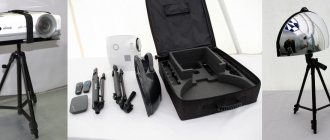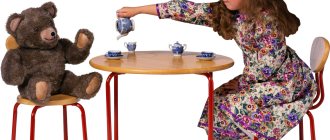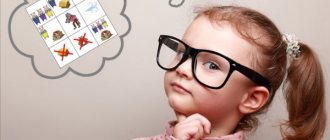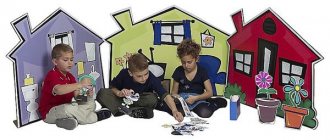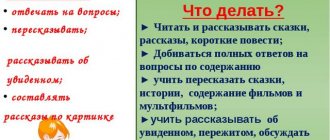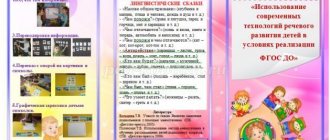When teachers begin to use innovative technologies in their work, as such visual techniques are already called, this makes it possible to balance the capabilities of all children. Due to their individual characteristics, children even of the same age develop differently and master the skills of using a brush, pencil, and paints in different ways. Sometimes a child is afraid that he will not be able to paint with a brush what he would like and may gradually lose interest in fine art. This does not happen if, along with the basic visual technologies, there are visual techniques of a slightly different type, requiring other skills, and sometimes allowing a completely unprepared child to create his own small work of art.
Quite often it happens that the most interesting from an artistic point of view are the works of those children for whom ordinary art classes are not easy. It is the opportunity to experiment, explore, try without fear of making mistakes that allows such children to reveal their artistic and creative potential.
Main tasks solved with the help of innovative technologies.
1.Development of children’s creative abilities, aesthetic perception of the surrounding reality. 2.Development of interest in experimenting with materials and means of representation. 3.Development of the ability to independently select materials, taking into account their inherent artistic properties, to choose means that correspond to the artistic concept.
The use of non-traditional technologies does not exclude the main tasks that the teacher sets for himself when conducting art classes.
Application
Application as a type of activity differs from others in the already existing forms of various objects, their parts, which do not need to be created or drawn. The main task in applique for preschoolers is to correctly place and stick the finished elements, thus recreating a decorative pattern or a certain image.
Applique classes contribute to the development of a sense of color, rhythm, symmetry, spatial orientation on a sheet and the formation of the first aesthetic tastes. During the course of work, the teacher should pay special attention to instilling organization in children. After all, creating an application requires a clear sequence of actions.
In order to enhance the manifestations of artistic creativity, we advise you to involve children in the production of individual and. collective works through the creation of images of objects of the surrounding reality through a harmonious combination of the various above-mentioned types of visual activities, materials (paper with clay, plasticine with natural materials) or techniques (appliqué from torn paper and palm painting) and the like.
Preschoolers really like this integration and contribute to the search for new interesting solutions in creating already familiar images.
Methodology for working with operational (technological) maps.
Operational cards allow the teacher to clearly and clearly introduce children to a new way of drawing; help children analyze what materials will be needed to perform work using a particular technique; what sequence of operations needs to be performed to achieve the desired result.
After the children have become familiar with the new technique, the operation card is placed in the center of the art. Children use it in independent activities to remember how to work with this technique. Gradually, as they become acquainted with other innovative technologies, a selection of cards is collected in the center, which allows the child to independently make a choice of techniques and materials in accordance with his idea.
Modeling
The uniqueness of modeling as one of the main types of visual activity lies in the possibility of creating a three-dimensional image. Thanks to the special plasticity of materials (clay, plasticine, dough), the child very quickly masters the skills of conveying the structure, spatial thinking, and dynamics of movement of the depicted object.
The main means of creating an image in sculpting is the transfer of a three-dimensional form. We also recommend using color, especially when coloring hand-made folk toys.
Description of visual techniques.
Sprinkling
Not an easy technique. Its essence is to spray drops using a special device, which in kindergarten will be replaced by a toothbrush and a stack (a wooden stick with ends widened in the shape of a spatula). Using a toothbrush in your left hand, we will pick up a little paint, and we will move the stack along the surface of the brush - with quick movements, towards ourselves. The splashes will fly onto the paper, and maybe not only onto it... That's all.
Over time, the drops will become smaller, they will begin to lie more evenly and where they need to be. But this will happen over time, so it’s better to start mastering this technique during a walk in the summer. Now let's get to work. "A napkin for mom." Let’s “spray” it with different colors and admire the resulting effect. "Snowfall". White “spray” on different colored backgrounds. White snowflakes dance and weave into a round dance. “Golden autumn has spun.” Spray the swirling foliage with gold paint. Use a brush to draw the trunks. Material: regular comb, brush or toothbrush, paint.
Using this method of drawing in your work, you can convey the direction of the wind - to do this, you need to try to ensure that the spray falls in the same direction throughout the entire drawing. Express seasonal changes vividly. So, for example, the leaves on the awn turn yellow and red earlier than on birch or other deciduous trees. They are yellow and green and orange on her. And the method of spraying will help to convey all this diversity. Children aged 6-7 years are engaged in spraying.
Drawing with palm, edge, fingers
Drawing technology: in the middle of the sheet the child draws with the edge of his palm, or with his palm or fingers. It is dipped in paint and imprinted on paper as necessary for the design it represents. Then the paint is wiped off with a rag. Materials: a sheet of landscape paper, sockets with gouache paint, brushes, a wet rag.
Lesson topics: “Tulips”, “Tree in summer”, “Spring tree”, “Rain”, “Mimosa”, “Edge”, “Fish”, “Rowan twig”, “A snowball is falling, falling”, “Magic butterflies”, “Festive Fireworks”, “Cheerful Palms”, “Chicken”, “Swan”, “Rabbit”, “Snail”, “Winter Tree”, “Sunshine”
Drawing with a candle
Material: paper, wax, paraffin candles, watercolors or paints. Gouache is not suitable for this method of drawing, because... does not have shine. You can use mascara.
First, the children draw with a candle everything that they want to depict on the sheet (or according to the topic). A magical drawing is obtained on the sheet, it is there, and it is not there. Then watercolor is applied to the sheet using the wash method. Depending on what you're painting, watercolor may be combined with ink. Similarly, work is performed using the “Watercolor and wax crayon” technique.
Mirror reflection
Develops imagination and creativity.
Materials: gouache of all colors, brushes, paper.
First, fold a sheet of paper in half. Then they unfold. Apply gouache stains of various sizes (at random). Then they roll it up again, run it with their hand, let the paint mix, unfold it and get anything they want, from moths to Christmas trees, from puppies to robbers. This type of drawing is very popular with children of all ages.
On crumpled paper
Painting technology: this technique is interesting because in places where the paper bends, the paint becomes more intense and dark when painted - this is called the mosaic effect. Drawing on crumpled paper is very easy. Before drawing, carefully crumple the paper, then carefully smooth it out and begin drawing.
Materials: crumpled paper, gouache paints, brushes, napkins.
Class topic: “Sea Kingdom”
Tamponation
A fun activity! Let's make a tampon from gauze (it can be replaced with a piece of foam rubber). The stamp pad will serve as a palette. Let's pick up some paints and, with light touches on the paper, we'll draw something fluffy, light, airy, and transparent.
In the younger groups - clouds, sunbeams, snowdrifts, dandelions. And it doesn’t matter that not only your heroes, but also your hands will become colored: they will wash off easily!
In the middle group, with a large swab it is very pleasant to draw fluffy chickens, funny hares, a kind snowman, bright fireflies (finishing the necessary details).
And older preschoolers can combine this technique with the “Stencil” technique in integrated classes (application and drawing). First, let's cut out the stencil. Who wants which one! Then, pressing it with your finger to a sheet of paper, we trace along the contour with light touches of the swab. Carefully lift the stencil... Miracle! Crisp and clear, it remained on paper! All the same things can be repeated in a different color and in a different place.
Painting technology: dilute watercolor paint in a saucer. Crumple the paper or plastic bag, dip it in paint and make an imprint on the paper. Then we will use a brush to complete the details of the drawing.
Materials: crumpled paper or plastic bag, watercolor paints, brushes, saucer, napkins, sheet of paper.
Lesson topics: “Spring foliage”, “Gardens have bloomed”, “Autumn foliage”, “Trees in winter”, “The owl is a wise head”, “Happy ducklings”, “Snowman”, “Winnie the Pooh and Piglet”
Monotype (obtaining an image by transferring it from one surface to another, imprinting the image)
One of the most interesting, colorful and inventive methods is monotype. To solve this, you need to have photo paper or any other paper (the higher quality the paper, the better the image), watercolor paints, soap, brushes or toothbrushes, water, glass or plastic plates. They can be of any shape and size.
The monotype technique requires the child to have developed visual skills, precision and accuracy, and the need for consistent actions. The difficulty of monotype lies in the quick creation of the drawing. Therefore, it is recommended: - at the initial stage of training, use the technique of co-creation with an adult; - the child should receive a sheet of paper with a ready-made fold line; — it is better to organize training in monotype technique with a subgroup of children.
Method of work: Watercolor is applied to a glass (plastic) base using paint, water, soap, and a brush or toothbrush. A sheet of paper is placed on top and an impression is made with your fingers, palm or swab. You can add the necessary details to the resulting image or leave the drawing as is. Frame the dried work.
Drawing with crumpled paper or plastic bag
Painting technology: dilute watercolor paint in a saucer. Crumple the paper or plastic bag, dip it in paint and make an imprint on the paper. Then we will use a brush to complete the details of the drawing.
Materials: crumpled paper or plastic bag, watercolor paints, brushes, saucer, napkins, sheet of paper.
The importance of visual activities for the comprehensive development of children
Fine arts classes, in addition to completing educational tasks, are an important means of all-round development of children. Learning to draw, sculpt, appliqué, and design contributes to the mental, moral, aesthetic and physical education of preschool children. Visual activity is closely related to the knowledge of the surrounding life. Initially, this is a direct acquaintance with the properties of materials (paper, pencils, paints, clay, etc.), knowledge of the connection between actions and the result obtained. In the future, the child continues to acquire knowledge about surrounding objects, materials and equipment, but his interest in the material will be determined by the desire to convey his thoughts and impressions of the world around him in pictorial form. M.I. Kalinin wrote about the importance of drawing for mental development: “A person who has learned and got used to drawing will have a special approach to each new subject. He will look at it from different angles, draw such an object, and he will already have an image in his head. This means that he will penetrate deeper into the very essence of the subject.” To correctly depict an object, you must have a clear idea of it, that is, see the characteristic features of the object, their relationship to each other, shape, color. The youngest preschooler in his drawings identifies only a few of the most striking features, which are sometimes insignificant. For example, when drawing a person, children sometimes depict glasses or buttons on a non-existent dress, considering them to be the main details. As a result of targeted learning, the child begins to highlight the main, essential things in what is depicted. In the process of visual activity, children’s visual ideas about surrounding objects are clarified and deepened. A child’s drawing sometimes indicates a child’s misconception about a subject, but it is not always possible to judge the correctness of children’s ideas by drawing or modeling. The child’s idea is broader and richer than his visual capabilities, since the development of ideas outstrips the development of visual skills. In addition, sometimes preschoolers deliberately violate the size and color of the image, trying to convey their emotional attitude towards the object. Thus, the child increases the size of the commander walking in front of the army to show his importance; he paints his favorite objects in bright colors, etc. In order for a child to be able to independently use the skills acquired by drawing one object in the depiction of a number of homogeneous ones, he must be able to generalize and operate with concepts. Currently, the question of the peculiarities of the development of a child’s thinking in connection with various types of activities has been studied quite deeply. In preschool age, in addition to visual-effective forms of thinking related directly to the process of practical work, a higher level of development of thinking is also possible - visual-figurative. Based on mental operations, the child can imagine the result of his work and then begin to act. The development of visual-figurative thinking occurs during the learning process. Research by the famous teacher N.P. Sakulina showed that successful mastery of image techniques and the creation of an expressive image require not only clear ideas about individual objects, but also the establishment of connections between the appearance of an object and its purpose in a number of objects or phenomena. Therefore, before starting the image, children solve mental problems based on the concepts they have formed, and then look for ways to implement this task. A child of senior preschool age is capable of creating such real and fantastic images that he did not perceive through the senses. Recent research in this area shows that the figurative principle in children's drawings appears already in early preschool age with appropriate educational work (see T. G. Kazakova, “Younger preschoolers draw,” M., 1971). Research by V. A. Ezikeeva shows how the image created by children aged 5-7 years changes in connection with their acquisition of experience and increased mental activity in the creative process. Visual activity is closely related to solving problems of moral education. This connection is carried out through the content of children's work, which reinforces a certain attitude towards the surrounding reality, and instilling in children observation, perseverance, activity, independence, initiative, the ability to listen and carry out a task, and bring the work started to completion. The life around us gives children rich impressions, which are then reflected in their drawings, applications, etc. In the process of depiction, the attitude towards the depicted is consolidated, since the child again experiences the feelings that he experienced when perceiving this phenomenon. Therefore, the content of the work has a great influence on the formation of the child’s personality. N.K. Krupskaya wrote: “We must help the child, through art, to become more aware of his thoughts and feelings, to think more clearly and feel more deeply; We must help the child to make this knowledge of himself a means of knowing others, a means of closer rapprochement with the collective, a means through the collective to grow together with others and move together towards a completely new life, full of deep and significant experiences.” Nature provides rich material for ethical and aesthetic experiences: bright combinations of colors, a variety of shapes, the majestic beauty of many phenomena (thunderstorm, sea surf, blizzard, etc.). Visual activities help to strengthen children’s ideas about the work of Soviet people and their way of life. For example, when getting acquainted with the city, the children draw a street on which houses stand in orderly rows, along the pavement in different directions, but cars move in a strict order, people walk along the sidewalks. In story drawings, children reflect their impressions of new buildings and depict various labor processes. Using appliqué tools, preschoolers create decorative patterns from vegetables, fruits, and flowers. During classes on these topics, the teacher talks not only about the design, shape of the depicted objects, their color, but also about the great labor that a person has to expend on the construction of new buildings, growing agricultural products, etc. All this significantly expands the child’s understanding of labor activity of a person, contributes to the labor education of a preschooler. In the process of drawing, sculpting, and designing, such important personality qualities as activity, independence, initiative, which are the main components of creative activity, are formed. The child learns to be active in observation, doing work, showing independence and initiative in thinking through content, selecting materials, and using a variety of means of artistic expression. Equally important is the cultivation of purposefulness in work and the ability to complete it. All methodological techniques used by the teacher in the classroom should be aimed at developing these moral qualities. In the process of visual activity, preschoolers develop a sense of camaraderie and mutual assistance. While working on an image, children often turn to each other for advice and help. At the end of the lesson, a collective analysis of children's works is carried out, which contributes to the formation of objective assessments of their own drawings and the drawings of their comrades. In some cases, the work of preschoolers is organized as a collective task, during which they develop the ability to work together, coordinatedly, and come to each other’s aid. Visual activity is of great importance in solving the problems of aesthetic education, since by its nature it is an artistic activity. It is important to cultivate in children an aesthetic attitude towards the environment, the ability to see and feel beauty, and develop artistic taste and creative abilities. The attitude of a 2-3 year old child to the surrounding reality is characterized by insufficient differentiation of the evoked feelings. A preschooler is attracted to everything bright, sounding, and moving. This attraction seems to combine both cognitive interests and an aesthetic attitude towards the object, which are manifested both in evaluative judgments about perceived phenomena and in the activities of children. Often, a younger preschooler gives a positive assessment of everything that is attractive and beloved to him, without taking into account aesthetic merits. For example, a child considers an old toy the most beautiful, since it is often used in play. Children also highly appreciate brightly colored, dynamic toys that have a smooth or fluffy surface, etc. A child of older preschool age more consciously highlights the aesthetic qualities of objects. In his answers to the question: “Why is it beautiful?” — motivations indicating the aesthetic features of objects predominate: proportionality, proportionality of volumetric forms, richness of color shades. Visual activity plays a big role in nurturing the aesthetic feelings of a preschooler. The specificity of drawing, modeling, appliqué, and design classes provides ample opportunities for experiencing beauty and for developing children’s emotional and aesthetic attitude to reality. Fine art shows a person the world of real-life beauty, shapes his beliefs, and influences his behavior. For the successful development of aesthetic feelings in preschoolers, it is necessary that the teacher, when preparing for a lesson, take into account the extent to which the task meets the interests of the children, their inclinations, and captures them emotionally. It is very important when explaining the task to specifically reveal the aesthetic content of the image object. Moreover, the teacher must talk about the elements of beauty in an object or phenomenon in an emotional, expressive form. If the teacher, having placed brightly colored objects as the basis for the drawing, analyzes them in an ordinary, even voice and does not find words expressing the brightness, colorfulness, unusual nature, then the children’s emotions will not be affected, they will calmly begin to “color” their drawings, not showing special interest in the depicted and his work. To consolidate moral feelings and deepen aesthetic experiences, it is necessary to create a certain emotional mood during the lesson. For example, when drawing on the theme “Spring”, it is good to use a poem about spring, listen to P. I. Tchaikovsky’s plays “The Seasons”. Visual activities contribute to the development of children's creative abilities, which is possible only in the process of assimilation and practical application of knowledge, skills and abilities. Taking care of the development of children's artistic abilities, the teacher must know the moments that are the first motivating factors for attracting children's attention and interest in drawing, modeling, etc. One of these factors is often the child's deep emotional experience when perceiving an object or phenomenon - a bright picture, books, toys, festive landscape. An emotional experience will cause the child to need to tell others about this or that phenomenon and show it through visual means. By creating a drawing, the child once again experiences the emotional upsurge that was present during the observation. He takes great pleasure in the process of drawing. The child has a desire to draw every day and depict in a drawing everything that he sees around him. Often the impetus for showing interest in visual arts is watching people drawing or doing sculpting or design. The process of adults creating vivid images in drawing, modeling, and painting makes an indelible impression on children and makes them want to try their hand. And as B.V. Joganson points out: “A person’s abilities await only a push for a person to clearly feel his calling.” The teacher’s personal example, help, demonstration, and explanation have a huge impact on the development of a child’s artistic abilities. A child of senior preschool age can understand many of the expressive means used by the artist. For example, in the illustrations for the fairy tale “The Snow Maiden,” the artist A.F. Pakhomov highlights the image of the Snow Maiden using color - all the people and objects around her have a real color, while the Snow Maiden is depicted in blue. This technique helps to emphasize her tenderness, fragility, and fabulousness. Children can understand that a fairy-tale image requires special pictorial forms and colors. Also, from paintings, children get acquainted with various compositional techniques for constructing an image - the transfer of the first and second plans, the choice of format, etc. In the visual activities of children, their creative abilities develop, which is one of the important tasks of aesthetic education. The organization and equipment of classes should also contribute to the aesthetic education of children. First of all, cleanliness, order, and neat arrangement of materials must be maintained: pencils must be neatly sharpened, paper cut into even sheets, clay rolled into a certain shape (ball or roller), etc. Accessories must be laid out on tables so that it is convenient and they are easy to use. Trays for paints or scraps of paper, glasses with pencils or brushes must be beautifully decorated. Such an environment will make preschoolers want to study, they will try to preserve and maintain beauty and order. Visual aids must be made at a high artistic level. All types of visual arts activities, when properly organized, have a positive effect on the physical development of the child. They help to raise overall vitality and create a cheerful, cheerful mood. Vision is of great importance for drawing and sculpting. In order to draw or sculpt an object, it is not enough just to see it and recognize it. The image of an object requires a clear idea of its color, shape, design, which the drawer can obtain as a result of preliminary targeted observations. The role of the visual apparatus is especially important in this work. In the process of visual activity, the child’s visual memory is actively formed. As is known, developed memory serves as a necessary condition for successful cognition of reality, since thanks to memory processes, memorization, recognition, reproduction of cognizable objects and phenomena, and consolidation of past experience occur. Fine creativity is unthinkable without operating with images of the child’s memory and ideas, obtained directly in the process of drawing, modeling, etc. The ultimate goal for a preschooler is such knowledge of the subject that would make it possible to master the ability to completely freely depict it from an idea. Drawing, modeling, appliqué, and design classes contribute to the development of the child’s hand, especially the muscles of the hand and fingers, which is so important for further learning to write at school. The labor skills acquired by children in the process of visual arts also develop the child’s hand and eye and can be used in different types of work. During classes, the correct training position is developed, since visual activity is almost always associated with a static position and a certain pose. Thus, fine arts classes are an important means of all-round development of children. continuation …
